CHAPTER IV
FIRST FEW YEARS OF THE NAVAL STATION
The Naval Reservation was formally turned over to the U. S. Government at noon, 10 December 1903, on board the U. S. S. Kearsarge, in Guantanamo Bay. The Commander in Chief of the North Atlantic Fleet represented the United States and Seņor Portuondo, Chief of the Public Works of the Province of Santiago, representing Cuba. Lt. Commander W. H. Allen, USN assumed command of the Naval Station that day as the first Commandant.
The first site for a Naval Station, to be located on the leased Naval Reservation, was recommended and selected by a board of five officers, of which Captain William Swift was the senior member. North Toro Cay and South Toro Cay were selected for the main activities, the principal structures and activities to be on South Toro Cay. These cays were originally separated by water at high tide. One of the first projects was to join them together by building a road across the marshy flats, thus forming a connecting neck of land. The two cays virtually became a geographical entity. Fort Toro, the Spanish stronghold mentioned in a preceding chapter, was on North Toro Cay, some distance above the boundary line.
There is a blueprint of a plan on file in the Naval Station Public Works Department, dated June 1904, showing the proposed development of the Naval Station on North and South Toro Cays. This plan was part of a report made by a board, probably the one of which Captain William Swift was senior member. The plan included on South Toro a large dry dock in the natural inlet in the center of the cay, plus a second dry dock in natural inlet on the western side; a wharf; ordnance piers; officers quarters; enlisted men's barracks; Marine barracks; supply buildings; quarters for civilians; and other facilities. On North Toro there was a section set aside for a hospital, southwest of Commandant's Hill, on which hill a million-gallon reservoir was to be built. Very little of the proposed plan was ever executed in the form of permanent construction. Few people know that a plan existed.
Lieutenant Commander Allen's tenure of office ran from December 1903 to May 1904, when he was relieved by Commander Charles C. Rogers, USN, who was in command for over two years, until September 1906. (Commander Rogers was later a Rear Admiral).
Work Advances
It was during Commander Rogers' period of command (May 1904-September 1906) that much of the work on the Naval Station was pushed forward. The million-gallon water reservoir on the top of Commandant's Hill was started. A smaller reservoir (100,000 gallon) as built and put into operation on another hill some distance to the south. In this operation water was brought from Guantanamo City to Caimanera where it was delivered from tank cars to station water barges; these barges were towed to the station wharf and the water was then pumped up to the 100,000 gallon reservoir. The station wharf had been built on the southwestern point of South Toro. Small water barges delivered water to various areas of the reservation, such as Hospital Cay and Fisherman's Point, having filled up at the wharf from pipes leading down from the small reservoir on North Toro.
On South Toro excavation for the big dry dock was undertaken. Station buildings were built, including a dispensary, machine shop, administration building, Marine barracks, and store houses-all on South Toro Cay except the dispensary which was on high ground between North and South Toro.
Along the north boundary line a 10 foot high concrete wall was built, extending across North Toro from Wireless Inlet to Granadillo Bay. The wall was completed in 1906. The first wireless (radio) station was also constructed in Commander Rogers' time, the location being on a northwest peninsula of North Toro Cay, the peninsula now named Wireless Point.
Other parts of the Naval Reservation were marked for development. Notable among them was the Fleet Rifle Range which was to be built in the general locality of the present Fleet Recreation Center, east of Evans Point. By 1906 much of the work had been done on this range, which the Fleet was to know so well in the years to come.
Fueling a Problem
Of the logistic problems confronting the Naval Station, the major
task was fueling of visiting ships. In 1905 a small coaling facility was located on Fisherman's Point. Early in 1906 it was moved to Hospital Cay, the small island in the bay already mentioned, where it was built up as a coaling station and maintained until newer methods of fueling ships with oil were inaugurated. By 1906 some living quarters had been built on Hospital Cay, in addition to the structures associated with the coaling station.
Turning again to the main activity on South Toro Cay, there was disappointment and disillusionment. Technical difficulties developed in the course of the excavation of the dry dock basin. This work had proceeded to where the excavation was completed and a dike, buttressed by the later addition of sheet piling, was in place. However, work was stopped in 1906. This is explained in an account which a Chaplain Glunt wrote in 1936, some of it perhaps apocryphal:
"During the time Commander Rogers was Commandant, many enduring features of the Base had their beginning. By far the biggest was the new Dry Dock Basin at south end of Toro Cay. There are many stories told in connection with this engineering venture. Perhaps the 'Shark' story is the best.
Shark Story
"Uncle Sam ... decided the Navy should build a large Dry Dock on South Toro in Guantanamo Bay, the newly acquired Naval Base off the Windward Passage on the southeast coast of Cuba. So he set dredges, steam- shovels, and engineers to begin the work about 1904. All went to work with a will, on a spot just below the Commandant's Hill, a place described above. They dug a big hole back into the peninsula in a cove. The hole was dredged bigger and bigger, and coral and fossil remains of the ancient sea-life were removed by tons and tons. Then the engineers decided it was large enough for a concrete dry dock for ships bigger than ever dreamed of at the time. They attempted to shut out the seawater by a dike, as they do in Holland. They began to fill in the entrance with mud, coral, and rocks behind it to block off the waters of the bay. The earth bank rose higher and higher, but still the waters prevailed. Finally, when the dike was above water, they started the huge pumps to lower the water inside, but, after pumping for several days, the water level 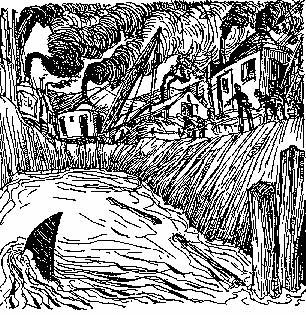 remained about the same. Interlocking pilings were shipped from the States to help solve the problem and were driven down deep into the dike. Again the pumps tried to prevail over the water, but the water level changed not at all. One morning, the Commandant, taking his usual morning stroll, came down to gaze on the persistent 'frog pond' and was greatly surprised. He could scarcely believe his eyes; for he thought he saw a shark's fin. He watched a few minutes and behold a large specie of Shyrna, about 12 feet long convorting in the waters of the Dry Dock Basin! Evidently the shark had entered the dock through an underground passage that supplied the water. The Commandant being a man of action, hesitated only a moment to give orders that all work cease on the Dry Dock Basin.
remained about the same. Interlocking pilings were shipped from the States to help solve the problem and were driven down deep into the dike. Again the pumps tried to prevail over the water, but the water level changed not at all. One morning, the Commandant, taking his usual morning stroll, came down to gaze on the persistent 'frog pond' and was greatly surprised. He could scarcely believe his eyes; for he thought he saw a shark's fin. He watched a few minutes and behold a large specie of Shyrna, about 12 feet long convorting in the waters of the Dry Dock Basin! Evidently the shark had entered the dock through an underground passage that supplied the water. The Commandant being a man of action, hesitated only a moment to give orders that all work cease on the Dry Dock Basin.
Dock Still Visible
"Today we can still see the remains of that huge unfinished project, blocked off from the Bay by a dike, and the corroded interlocking pilings, with water inside, at the same level of the Bay. The wild guineas pick gravel on the shore, and the iguanas have holes in sides of the Dock Basin, while thorny Cuba brambles slowly envelope the site of the old Naval Station on South Toro Cay. 'The plans of mice and men gang aft agley', and 'man proposes, but God (and nature) disposes'."
It might be said in passing that other things contributed to the demise of the dry dock. One was lack of funds. Another was lack of support in Washington. Many people saw in the dry dock and the build-up of a Naval Station an economic threat to Navy Yards, existent or projected, at Charleston, Pensacola, Key West, and New Orleans. Then there was the contention that the location of the dry dock was poor from a defense standpoint. An enemy ship could stand off the entrance to the Bay and shell the dock with no intervening land obstacles. (This was the military logic of those early days). Of course, the inability to seal the excavation against leakage gave the dry dock the coup de grace.
The order to stop the construction of the dry dock basin had a sweeping negative effect on the further development of that site for the budding Naval Station, and caused a delay in the formation of definite plans for the use of the Reservation.
In the early days the Commandants lived aboard station ships since there was no suitable quarters ashore. In some cases, they also commanded the station ships. The station ships generally anchored south of South Toro Cay. Records indicate that the USS Amphitrite, a monitor, under the command of Lieutenant Commander Edwin H. Tillman, USN, was first designated as station ship in Guantanamo Bay. It is assumed that the first Commandant was quartered aboard this ship. The second Commandant, Commander Rogers, is known to have lived aboard the Amphitrite. Later a second ship, the Monongahela, arrived. The third Commandant, Lieutenant Commander Albert A. Ackerman, USN, lived on the Amphitrite from his arrival in September 1906 until December 1906 when Mrs. Ackerman arrived and they moved to the Monongahela and took quarters aboard. He wrote later that "the change from the cramped, hot, underwater cabin of the Amphitrite was as good as a promotion".
Quarters Built
During the Ackerman regime starting in September 1906, the quarters for the range officer were completed on Evans Point (December 1906). This was a large wooden bungalow with a 15 foot veranda around it. (As Quarters X it subsequently had many uses, among them being shore headquarters for the Commander-in-Chief, Atlantic Fleet).
Lieutenant Commander Ackerman built a civilian quarters building near the dry dock on South Toro and civilians were moved in. Money was procured for a temporary Commandant's house, near the abandoned dry dock, and the house, an improvised wood structure, was built. However, another officer (Lieutenant Victor Tomb) and his family were assigned to it. Also a temporary club-house, store house, and some primitive buildings were put up on Deer Point, primarily for service to the Fleet when present.
It was Lieutenant Commander Ackerman who started the Naval Cemetery on North Toro Cay, long since abandoned but still appearing on charts of the area. Through diplomatic channels British consent was obtained for the transfer of the remains of a British officer from Hospital Cay to this Cemetery. The officer in question was E. N. Harrison, Paymaster, Royal Navy, HBMS Buzzard, who died from yellow fever 1 December 1854, and was buried on Hospital Cay. All bodies have since been removed from the North Toro Cemetery. Some of them, including the British Paymaster, were reinterred at the Naval Cemetery at Cuzco Beach.
Army Builds Forts
Fisherman's Point in those days was used primarily for lookouts and pilots. In 1906 an Army contingent of some 60 men, under the command of a Captain Schulz, was stationed there, together with some Army civilian employees. The Army had the responsibility for the defense of the Naval Reservation, and in those days coast artillery was most effective against attack from the sea, as was to be demonstrated in World War I. This Army contingent, mostly engineers, had the job of building two forts. The first and smaller, Fort McCalla, was located south of the Cable Station and consisted of two separate concrete sections, each with two small gun emplacements. It was built in 1906. The second was Fort Conde, located on a bluff by that name, west of Hicacal Beach. This concrete fort, with emplacements for two 6" guns and four mortars was constructed in 1907. The two 6" guns are said to have been mounted but never fired. If mounted, they were later removed. Neither fort apparently was ever manned for coast artillery purposes.
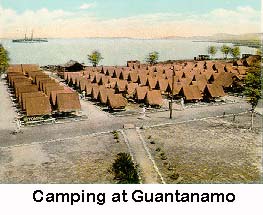
After building Fort Conde in 1907, the Army left the area, and the Marine Guard, some 20 strong with a Sergeant in charge, occupied the quarters and buildings the Army left at Fisherman's Point, having moved from their barracks on South Toro. This was sometime in 1908, as far as can be ascertained. The Marines constructed other buildings from time to time.
Work was completed on the rifle and pistol ranges in 1907. The million-gallon reservoir was almost finished, but no connection was made to the Station wharf. Ditches still in evidence were dug for 12" pipe, but the pipe was never laid. The development of Hospital Cay by this time consisted of a coal wharf on the west side; on the east, a carpenter shop, paint shop, boat shop, a tiny marine railway, and some primitive living quarters; on the south end was a blacksmith shop. A water distilling plant was also erected in 1908 on the north end, together with a 650,000-gallon water tank. This plant was never made to work. Contrary to at least one account, the first station hospital was not on Hospital Cay, nor did any of the early Commandants live there.
Revolution of 1906
Meanwhile, life at this budding Naval Station was complicated by a revolution in Cuba. (Twenty years later, Lieutenant Commander Ackerman, then a Captain, wrote about it in a letter which is appended). The revolution had been underway in the western provinces for two months when Lieutenant Commander Ackerman came through Havana in September 1906, on his way to Guantanamo. The Cuban Government had appealed to the United States, and President Roosevelt had sent Secretary of War Taft and a party to Havana to reconcile the discordant factions. This failed, and President Estrada Palma resigned on 28 September 1906, whereupon Secretary Taft proclaimed a provisional government, which undertook to restore order, with the help of U. S. troops. This was the first of several United States interventions to come, pursuant to the Platt Amendment.
Shortly after Lieutenant Commander Ackerman took over his duties as Commandant, the revolution had spread to Oriente Province. From Guantanamo City there were rumors and reports of burnings, cattle stealing, and threatened atrocities at different plantations in the area, on the part of the insurgents. General Perez, who had been so helpful to Commander McCalla in the Spanish-American War, was the local insurgent leader. Apparently he had his revolutionists under better control than rumored. However, there were appeals for protection from various Americans located on the plantations. This prompted the Commandant to organize a relief party for possible use. He armed nine steam launches and two tugs and organized a landing force of a little over 100 men. plus the Marines, who numbered about 20. (At this time the station enlisted complement, practically all afloat, numbered about 200 men). The landing force had their packs, ammunition, and a couple of field guns on one of the tugs prepared for embarkation on a train kept ready at Caimanera. It turned out that there was little fighting in Oriente, and it was not necessary to dispatch the landing force. United States intervention had the requisite steadying effect.
Among the U. S. troops landed in the intervention was a Marine detachment of about fifty men under Captain H. C. Reisinger, USMC, which arrived at Guantanamo Bay in late October 1906, and proceeded to Guantanamo City. This detachment did not remain in Guantanamo City long since the area had quieted down under the U. S. provisional government, which was to terminate after a national election held in November 1908. The revolution and the ensuing U. S occupation had little further effect on the Naval Station, but the Marine detachment remained in the area until April 1909.
Blueprint Missing
Search has been made in vain for a blueprint showing the layout and extent of the Naval Station in the early years, specifically for 1907-08 period when it appears to have reached its peak of development on North and South Toro Cays. In order that the history of this period may not altogether die for want of records, as it eventually would, the writer has personally explored these cays and has located the sites of all the principal buildings and landmarks. Such would have been most difficult had it not been for the help of Alfred D. Hinds, a Jamaican employee, who came as a boy of 16 to work at the station in July 1906. Although he had not been on Toro Cay since 1912, he was able to lead the writer and his orderly, through brush that has grown up over the years, to the location of each old building site. From these explorations, the writer has been able to reconstruct a map of the Naval Station as it existed forty-five years ago. This map, or sketch, is appended for reference. Also sketches of Fisherman's Point and Hospital Cay have been reconstructed in a similar manner-no old blueprints being available for them either.
Of the prominent landmarks of this era, the dry dock excavation is the biggest, but the most permanent is the huge reservoir atop Commandant's Hill. It is a lasting monument to the indecision which plagued the infant station. The hill is steep and rocky. However, the view of the Naval Reservation and adjacent Cuba, as seen from the reservoir, was well worth the energy expended in the writer's explorations. Climbing the hill is not recommended, however, for those with faint heart.
Fleet's Winter Home
The natural and man-made facilities offered by Guantanamo Bay led to the Atlantic Fleet making it their winter training grounds. The Fleet, in whole or in part, made frequent visits to Guantanamo, where they found an equable climate, a good anchorage, coaling facilities, rifle ranges, and a superb operating area. Lieutenant Commander Ackerman writes at some length on this matter, referring specifically to a visit by Rear Admiral Robley D. Evans and his Fleet that was later to go around the world. (It is obvious how Evans Point got its name).
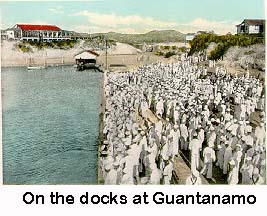
At about this time, according to Captain Ackerman, the station "was visited by Secretaries Metcalf and Newberry and by the Senate Naval Committee of which Senator Hale of Maine was Chairman. Penrose of Pennsylvania was another member". The visit of this official party indicated that interest in Guantanamo Bay still existed, and their report no doubt had an important effect on the future of the Naval Station.
Lieutenant Commander Clark D. Stearns, who was Range Officer under Lieutenant Commander Ackerman, succeeded him as Acting Commandant in August 1907. Lieutenant Commander Stearns was the first Commandant to live ashore. He had been Range Officer and he continued living ashore in the Officer's quarters on Evans Point. He was not living on board the USS Monongahela when it burned.
The USS Monongahela was launched in Philadelphia in 1862. She was a wooden hull steamer that fought under Farragut in the Battle of New Orleans and in several other engagements. After the Civil War her engines were removed and she was converted into a sailing ship. As such, she had sailed on many cruises and was well known in the Navy. From 1894 to 1903 she was a training ship. Her assignment as station ship at Guantanamo Bay was short-lived. In the spring of 1908, while anchored between South Toro Cay and Granadillo Point, she caught fire. While afire she was towed and beached at a spot on the south side of Deer Point, a few hundred feet east of the present Base Commander's boat landing. Much was salvaged but the ship was a total loss. After a few weeks she settled on her side and submerged.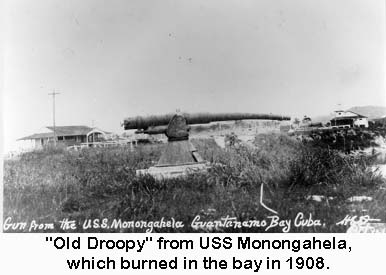 From a helicopter the hulk may be clearly seen lying in about 12 feet of water. A gun whose barrel "drooped" perceptibly as a result of the intense heat was salvaged from the wreck. Apparently it was such an oddity that it was mounted on the cliff overlooking the Monongahela's resting place, in what is now the backyard of quarters 1105. During the approximately 40 years it was there the gun became somewhat of a landmark, exciting much curiosity. In recent years it was transferred to the tip of Deer point, outside the wall enclosing the Base Commander's yard.
From a helicopter the hulk may be clearly seen lying in about 12 feet of water. A gun whose barrel "drooped" perceptibly as a result of the intense heat was salvaged from the wreck. Apparently it was such an oddity that it was mounted on the cliff overlooking the Monongahela's resting place, in what is now the backyard of quarters 1105. During the approximately 40 years it was there the gun became somewhat of a landmark, exciting much curiosity. In recent years it was transferred to the tip of Deer point, outside the wall enclosing the Base Commander's yard.
Pawley Store
One item of passing interest is worth recording. About the year 1908 a branch store of E. P. Pawley Co. of Caimanera was opened on South Toro near the station wharf. This store sold general merchandise and furnished a much needed service (this was before the days of ship's service stores), although it was probably contrary to the lease agreement which forbade private enterprise on the Reservation. The proprietor of the enterprise was an American, Edward P. Pawley, who was a businessman in Caimanera from 1904 to 1917. He had five sons, one of whom, William D., attained great wealth and was American Ambassador to Peru and Brazil in recent ears.
Soon after the Monongahela's burning the USS Newark, with Commander Charles H. Harlow, USN, in command, came to relieve the crew of the Monongahela, who were living ashore at Deer Point, and from reports, quite contented. This was in May 1908. Commander Harlow relieved Lieutenant Commander Stearns as Commandant and served as such until April 1909. He continued to live on board the Newark. During his time he was directed to make a survey of the inlet between Corinaso Point and what was later to be called Radio Point. He reported conducting this survey with only a sextant, hand lead, and pencils and submitting the results on brown wrapping paper. He wrote of this later. Also he recalled asking the civil engineer who prepared the plans for the station buildings why the pitched roofs were so steep, and the answer was that it was the accepted pitch for snow!
Commander Harlow was sent home in April 1909 in poor health, which proved to be only temporary as he remained on the active list for many years. He was relieved by Lieutenant Myles Joyce, who acted as Commandant from May to November l909. Little is known of him except that he lived ashore at the Wireless station, and did not take quarters aboard the station ship.
Goat Incident
By this time in the life of the station several family quarters had
been built at various places on the station-notably on Toro Cay, Evans Point, Hospital Cay, and Fisherman's Point. They were occupied by officers' families but living conditions were not too pleasant and the families none too happy. Things did not always run smoothly. There are tales of early friction between families. One interesting tale concerned a pet goat owned by a Marine officer. Apparently this goat annoyed the station surgeon on numerous occasions and finally to the extent that the surgeon got out his rifle and shot the goat. Ensued much hard feeling and recrimination between the Marine officer and the surgeon, and it became so acute that the Commandant (who will not be named) was apparently about to take a hand in the matter on the side of the Marine officer, with disciplinary action in the offing.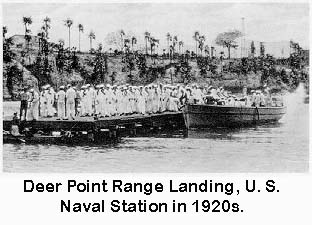 About this time the Commandant developed a serious cardiac condition, according to the diagnosis of the surgeon, which resulted in the sudden transfer of the Commandant back to the United States. Disciplinary action against the surgeon for shooting the Marine officer's goat came to a halt. The Commandant's heart condition miraculously cleared up before he arrived in Washington. Nothing further happened. This story is related by Commodore Dudley W. Knox, U.S.N.(Ret) who was a later Commandant, and who is still living. He knew the surgeon in the case and states that the surgeon privately admitted his part in the episode.
About this time the Commandant developed a serious cardiac condition, according to the diagnosis of the surgeon, which resulted in the sudden transfer of the Commandant back to the United States. Disciplinary action against the surgeon for shooting the Marine officer's goat came to a halt. The Commandant's heart condition miraculously cleared up before he arrived in Washington. Nothing further happened. This story is related by Commodore Dudley W. Knox, U.S.N.(Ret) who was a later Commandant, and who is still living. He knew the surgeon in the case and states that the surgeon privately admitted his part in the episode.
Go to Chapter Five